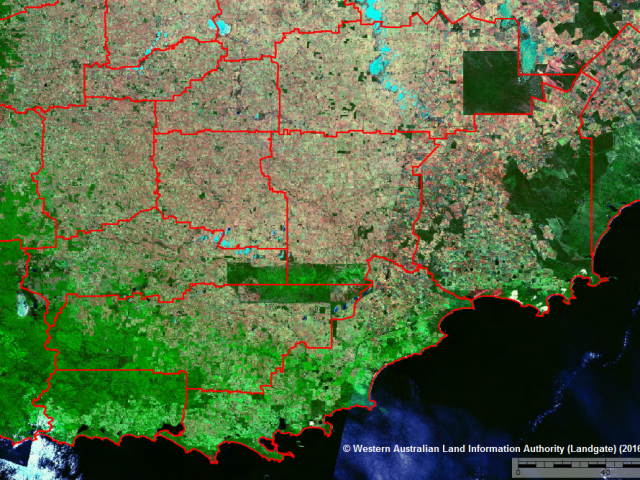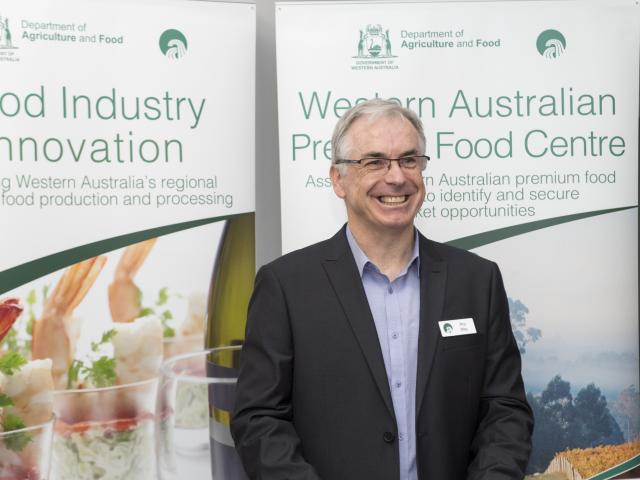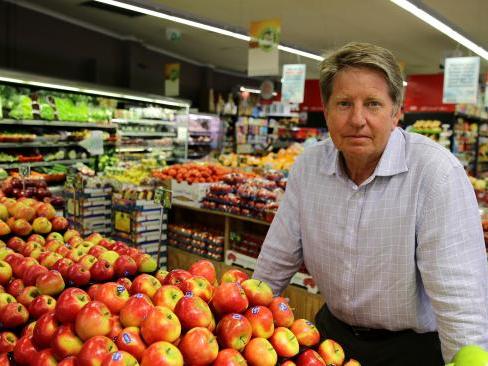Food Industry Innovation project overview
It has been an exciting and busy time for the Food Industry Innovation project with the launch of the Western Australian Premium Food Centre, the food production and processing capacity survey of the Great Southern getting underway and participation in two major conferences, Seizing the Opportunity Agriculture (STOA) and Sustainable Economic Growth for Regional Australia (SEGRA) exposing the project to the wider business community.
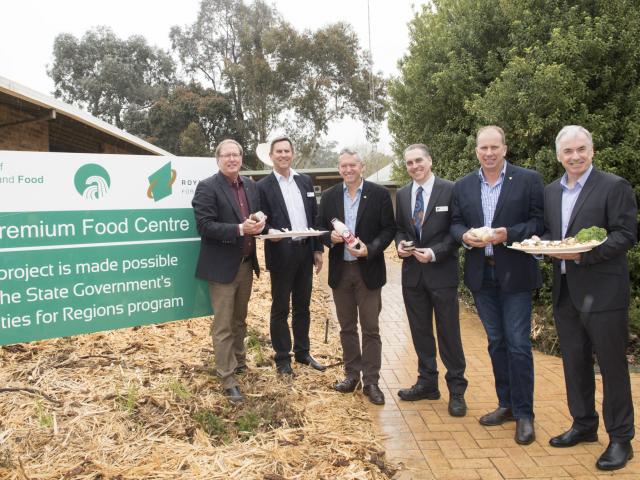
Food Industry Innovation Project Manager Kim Antonio said the level of participation from industry at the launch of the Western Australia Premium Food Centre was testament to the interest industry has in the project.
“We certainly feel there were real benefits that accrued from having DAFWA’s A/Director General and the Minster for Agriculture and Food spending time at the launch and in and around the region, meeting producers and seeing how their businesses operate. The additional benefit of having high-level government involvement pre and post the launch was definitely significant for the project” Kim said.
Agriculture and Food Minister Mark Lewis, who officially opened the centre was impressed by the agrifood businesses he visited while in the region.
“It was great to see the level of enthusiasm from industry at the Western Australian Premium Food Centre launch and I was delighted to be able to meet with innovative producers in the region and visit new developments, like the high pressure processing facility at Fresh Produce Alliance producing an exciting new range of Avovita avocado smoothies and mousses and Born Pure baby food.”
Ben Darbyshire, Chairman of FruitWest, reflected and industry view following his attendance at the launch.
“It was great to see ministers, industry representatives, DAFWA and other agency staff interacting in such a positive way. The Western Australian Premium Food Centre has generated a lot of enthusiasm and gives new momentum to this regionally based facility that plays an important role for industry” Ben said.
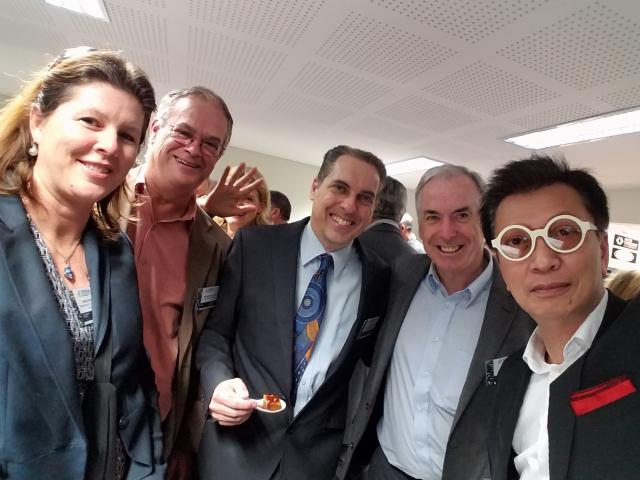
Kim Antonio said participating as a guest speaker in the SEGRA 2016 program and attending related networking events provided a great opportunity for the project to gain addition exposure and make some valuable connections.
“It was great for the FII project team to spend some time with Idris Mootee at the SEGRA 2016 conference in Albany. Idris, the CEO of Idea Couture is an internationally acclaimed strategic innovation expert who advises top executives of Fortune 500 companies.
“We were delighted to have the opportunity to discuss our project with him at the networking dinner and get his insights into our industry and our project direction.”
For more information contact Kim Antonio, Food Industry Innovation Project Manager
Phone: +61 (0) 8 9368 3676 or email kim.antonio@agric.wa.gov.au
Western Australia’s Premium Food Centre unveiled
After months of planning and preparation it was a very exciting and pivotal moment for the Department of Agriculture and Food, Western Australia’s (DAFWA) Food Industry Innovation project when the Western Australian Premium Food Centre was launched by the Minister for Agriculture and Food, Mark Lewis early in October.
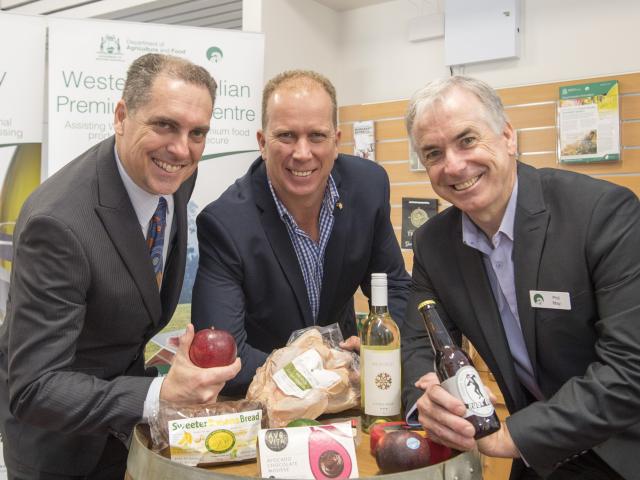
The opening marks the official beginning of what is sure to be an exciting journey for Western Australia’s (WA) premium agrifood businesses as the Western Australian Premium Food Centre, based in Manjimup, works to help convert trade prospects into partnerships for this sector.
At the event, 80 invited guests, predominantly from industry, were treated to a selection of premium food products, catered for by a former South West Chef of the Year, Raj Thyagarajan, from Cilantro Café.
As part of the formalities, Phil May, Western Australian Premium Food Centre Manger, was able to highlight some of WA’s already successful premium producers who featured on the menu at the delicious morning tea including Holy Smoke, Newton Orchards , The Truffle & Wine Co., Omega Walnuts, Bridgetown Cidery, Sally’s Lane and Blue Ridge Marron.
Phil said “it was a very successful event. Feedback from those attending the launch praised the mix of delegates in attendance. The combination of politicians, government and industry representation contributed to extended networking after the formalities had finished.
“We certainly felt that because of genuine interest in the project the launch was truly a celebratory event”, Phil said.
Minister Lewis said the Western Australian Premium Food Centre, supported by a $3 million investment from Royalties for Regions, would assist agricultural producers and processors to work together to capture a share of the growing global premium food market.
"The Western Australian Premium Food Centre will enable the local agrifood industry to build on its enviable reputation and capitalise on growing domestic and international demand - particularly from Asia - for reliable suppliers of high quality, safe, premium products," he said.
"The centre will work with agribusinesses throughout WA, including the organics industry, that are actively pursuing market expansion. These businesses will make an important contribution to realising the Liberal National Government's vision to double the value of agriculture by 2025.”
Minister for Regional Development, Terry Redman said the centre would support suitable agribusinesses in their endeavours to become competitive, providers of premium agrifood products.
"These investments will equip WA agribusinesses with the skills and market intelligence to stand out in the international marketplace as preferred premium food suppliers,” he said.
"In doing so, these projects will expand the agriculture sector and the region's contribution to the economic and social wellbeing of WA.”
Agriculture is WA’s second largest export sector, employing 40 000 from across the state.
For more information or to register your interest in the Western Australian Premium Food Centre phone +61 (0)8 9777 0162 or email Phil May at phil.may@agric.wa.gov.au
Great Southern food mapping project forging ahead
Mapping Great Southern food production and processing businesses and their current and future production capacity is the first step to understanding the capability of the region as a whole with a view to identifying new opportunities.
As a major part of the Department of Agriculture and Food, Western Australia’s (DAFWA) Food Industry Innovation Project and made possible through Royalties for Regions investment, the Specialised Food Centre is focusing on the large number of premium agrifood businesses already operating in the Great Southern and Wheatbelt region.
Mapping the location of those businesses and their current and future production capacity is the first step to understanding the capability of the region as a whole with an ultimate view to identifying value-adding and collaborative opportunities.
DAFWA formed an important partnership early on in this project with Regional Development Australia Great Southern (RDA) to produce a food production and processing map, now headed by the RDA’s newly appointed research officer Andrew Bathgate.
Surveys were sent out mid October and responses have been flowing in from primary producers and processors from across the Great Southern.
“This is the starting point of a process where we are ultimately trying to match market opportunities with capacity in the region,” Andrew said.
“The overall objective of the state government is to double the value of agriculture by 2025 and this project is a small part of that bigger picture.
“We have designed a survey for farmers, fishing groups and processors to gather information that will help us work out what production is occurring in the region and what their capacity on the ground is.”
The survey has been emailed to a contact database that was created specifically for this project and other methods of promotion will be through websites, posters, mail outs and meeting as many businesses as possible face to face to improve the response rate.
Andrew said they had already received great support from grower groups and local councils that were happy to help promote the survey to their members.
“With the survey results we will develop a food map which shows the extent and intensity of production in different parts of the Great Southern region,” he said.
“We are also trying to determine what constraints there are that might limit growth to business development, such as collaboration between growers, capital constraints, access to markets, market information, input costs and availability of labour. This is all with the view to try and enhance capacity to overcome those constraints.”
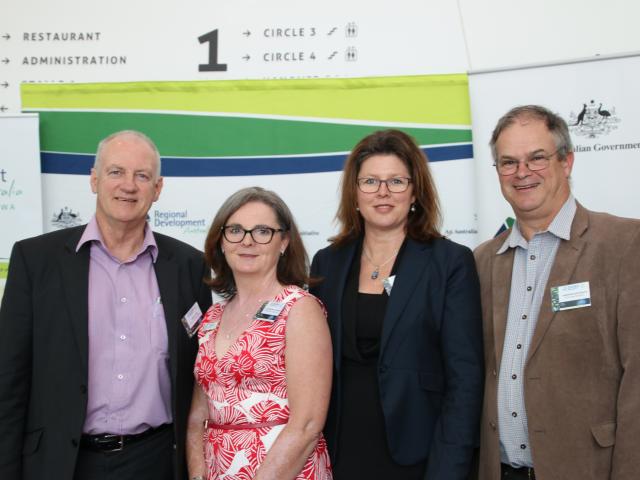
In addition to getting the survey underway, the Specialised Food Centre team have secured financial support for the survey from local councils and shires, who are interested in the data because it will help develop a product register for the region.
This product register will be useful for councils to direct groups, who are interested in buying products from the region, to one place that lists what type of products and where they are available.
Financial support has already come from the Great Southern Development Commission, South Coast Natural Resource Management, City of Albany, Shire of Denmark, Shire of Plantagenet, Shire of Cranbrook and Shire of Gnowangerup.
And in-kind support from Gillamii Centre, North Stirlings Pallinup Natural Resources, Albany Regional Commercial Horticulturalists, Great Southern Food Network, Lower Great Southern Economic Alliance, Shire of Broomehill-Tambellup and Greenskills.
The survey will close on December 2. If you are interested in participating, and are a food producer or processer in the Great Southern region, please contact DAFWA’s Specialised Food Centre Manager Nikki Poulish.
Phone: +61 (0)8 9892 8415 or email nikki.poulish@agric.wa.gov.au
Meet the team: Western Australian Premium Food Centre’s Phil May
When it came to searching for the right person to manage the Western Australian Premium Food Centre, experience in the luxury end of the agrifood sector seemed a must.
So when Phil May came along, a man who has been involved in the wine-making industry for 35 years with experience selling into Asian markets, the fit seemed just right.
From an early age Phil knew he wanted to be a winemaker. He joined his wine-making uncle on his property in South Australia’s Clare Valley on school holidays in 1979 and never looked back.
After completing his Agricultural Science studies, with a major in viticulture, he began his first vineyard management role in 1983.
Three years later he was offered a role in winery management and learned his winemaking skills under the direction of consulting winemakers, including the creator of Penfold’s Grange Hermitage, the late Max Schubert.
After stints at different wineries in South Australia and Victoria, the temptation to become a pioneer in Western Australia’s (WA) largely unknown Pemberton wine region resulted in a move to Manjimup in 1991. He was given the opportunity to develop and launch the Smithbrook wine brand, with responsibilities for vineyard, winemaking and business management. Aided by wine show success and third party endorsements, Smithbrook gained a public profile that attracted several parties interest in buying the business and it sold in 1997.
After the sale of Smithbrook, Phil established a Manjimup-based wine industry consultancy servicing all of WA. In 2001, he undertook a consulting assignment in China, which marked the beginning of many regular forays into Asia.
Soon into the new millennium, the Australian wine sector began to change. Increased production and reduced grape prices threatened the viability of the industry.
To move with the times, Phil worked with his consulting client base to establish a collaborative winemaking entity —The Growers wine company was founded and Phil moved to Margaret River.
Winemaking, vineyard development and finding international markets have all been part of his varied career and is a great foundation from which to direct the Western Australian Premium Food Centre.
However, it is his knowledge of brand building and identifying market opportunities that is likely to be of most benefit to the role.
“An ability to identify gaps in the market and then fill the gaps with a product demanded by the market will assist in attaining sales success,” Phil said. “It has been a strategy that has historically worked well for me. I identified an opportunity to export Australian wine into China and, although it took a few years to develop, in the financial year ending 2008, one in every three bottles of Western Australian wine going into China, was wine I had made.”
The Global Financial Crisis encouraged Phil to look to identify new market gaps.
“Online wine sales was one such identified market opportunity,” he said. “Before it was common practice, I moved into transactional wine buying website development”.
His career highlights include a multi award-winning riesling he produced from the 2004 vintage that was dedicated to his uncle.
“However, more than any winemaking, vineyard development or sales success, I am proud to have continued with the pursuit of my winemaking passion for as long as I did,” he said.
Phil has been excited to return to Manjimup and establish and manage the Western Australian Premium Food Centre.
“The future of the WA premium agrifood sector is bright and the opportunities are only limited by our imagination,” he said. “Western Australia enjoys a wide range of soil and climate options, produces agrifoods that are recognised as safe and clean, is well located to service the growing economies within Asia and has the skills base to capture market priorities.”
Profile: Greg Brindle, Brindle Group chairman
Greg Brindle runs a portfolio of smaller boutique retail stores in the Perth metro area and is constantly looking for ways to compete against the big retail giants.
His portfolio includes IGA stores in Wembley, Leederville, Canning Bridge and Shenton Park, The Good Grocer in Applecross, Rottnest General Store, Rottnest Geordie Bay Store and Rottnest Bakery.
To find a point of difference and distinguish his stores from the rest he launched a private label, premium product range called The Good Grocer Collection 12 months ago.
The concept was to find unique Western Australian food products that were fresh and of high quality, that couldn’t find their own distribution and re-label them under a clean, established brand aimed at the upper end of the market.
“A lot of small, cottage industry-style producers were struggling to find a market,” he said. “What we can do for, say the little cheese producer down in Denmark who doesn’t have the resources, is help with packaging, labelling and distribution. We can help take a quantity from them and give them an immediate presence in eight supermarkets. Otherwise that cheese producer has to hop in a car with an esky and go from one supermarket to the next selling very small quantities and, regrettably, that is where a lot of these small producers are at.
“Collectively as a group our offer and style is all about fresh, high quality and premium products. We already had some value in our Good Grocer store, which is a top end premium supermarket in Applecross, so we used that branding for this premium product range.
“The motivation for creating the premium, boutique private label as just another way of differentiating from our bigger competitors. It was to give our customers a point of difference.”
Greg said determining what to include in the collection was a process of analysing the products available and looking at where they could value add at the top end in a category range.
“We will look for categories where we think we can add some value by providing a better quality product at a value price. There are plenty of great cheeses around, but which producer is doing something special but finding it hard to get distribution, that is where we can work together with them.
“So there were two motivations for bringing in this range, to complement and value add to a category of products and provide our customers with a sense of uniqueness, that you can only buy this particular product in one of our eight stores.
“We also have a set of guidelines that a product has to meet before we take it on, it has to have a sense of uniqueness, it has to represent value and it has to be of high quality.
“We have found that we can now talk to our suppliers and there are some opportunities for them to custom build a product for us that is unique to The Good Grocer Collection, which is another way to differentiate from the others.”
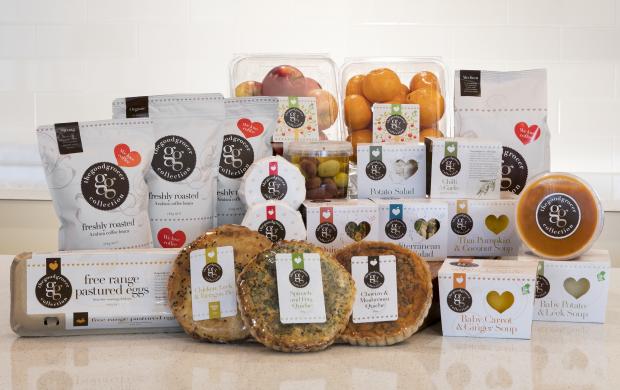
So 12 months in, have there been any barriers to creating this collection?
“When you are dealing in that fresh area it has a short life so you have to be careful with shrinkage and use-by dates, that can be a challenge for the producer and retail store,” Greg said.
“That is always going to be a challenge because you need to have a strong discipline around process and we think we are getting better at it.”
Another area they plan on addressing was to better convey the background story of the producer.
“There are some great stories with these smaller producers and while we try to get a bit of that out on the packaging, we don’t want to clutter it with too many words, so it is predominantly done internally with an aggressive tasting program,” he said.
“The producers can come into the store, hand sell and talk up their product or we employ tasters to give the background story on these producers. We haven’t developed an advertising platform yet for the collection so that is something we will work towards and do a better job at spreading the word.”
The release of The Good Grocer Collection has been more successful than Greg had anticipated and he plans expanding it in the years to come.
“The consumer understands the range, they are talking about it and enjoying it and our repeat sales are strong. We set a budget for the first 12 months in terms of sales and we got there in eight months,” he said.
“We have around 50 different varieties of products across 15 categories and I would hope to be moving that to 50 or 60 categories in the next 12 months. I can see us having around 300 products over the next two to three years and that won’t be just refrigerated items, that will be shelf items as well.”
Food Industry Innovation Manger Kim Antonio is happy with the level of interest and enthusiasm the project is receiving from industry.
“It is great that companies like the Brindle Group reached out to make contact with the Food Industry Innovation team at the commencement of the project.
“It’s been highly beneficial meeting with brand and product development manager Francesco Taranto and group buyer Gary Lay to discuss some of the wonderful premium Western Australian products we work with and share opportunities for collaboration.”
For more information on how your business can connect with the project, contact Kim Antonio, Food Industry Innovation Project Manager.
Phone: +61 (0) 8 9368 3676 or email kim.antonio@agric.wa.gov.au
Fast facts: Food Industry Innovation features at STOA and SEGRA conferences
Taking the message of the Food Industry Innovation project to the wider market took a big leap in the past two months with appearances at the Seizing the Opportunity Agriculture (STOA) conference in September and at the national Sustainable Economic Growth for Regional Australia (SEGRA) conference in October.
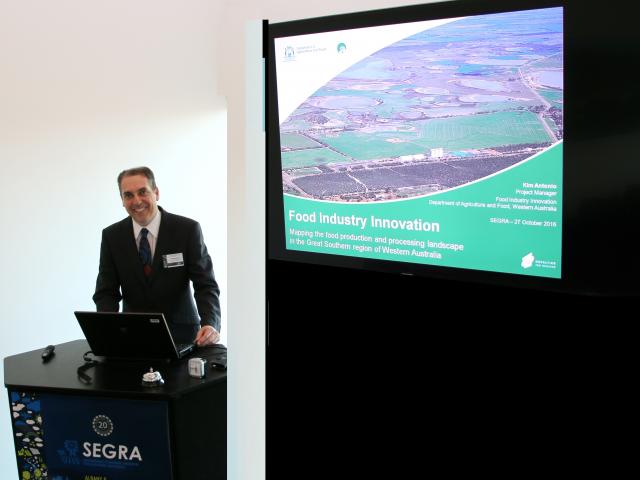
Food Industry Innovation Project Manager Kim Antonio addressed the 2016 Albany and Great Southern SEGRA conference to outline how this project would help create a more viable and sustainable future for regional agrifood businesses in the Great Southern.
He demonstrated that with a solid base of producing $1 billion of agricultural produce per year, the Great Southern was already contributing strongly to the economy but that there was more market share to capture.
The aim of the Department of Agriculture and Food, Western Australia’s (DAFWA) Food Industry Innovation project was to create more competitive and viable agrifood businesses in the region by identifying opportunities for collaboration in production and processing.
It will be done through identifying and capturing premium market opportunities that are currently being missed by some businesses.
Conducting the Target Market Opportunities Report for Western Australian premium products had been one such investment to identify these premium markets, through DAFWA’s Asian Market Success project. Results had shown there were 20 opportunities identified across nine food and beverage platforms in Asia for WA premium products including beverages, processed foods, dairy and eggs, some fruits and vegetables, seafood, meat, oils and grains.
Kim explained to the conference that commissioning a survey to create a food production and processing map of the Great Southern would be another way of identifying what the current and future capacity of the region would be.
The survey results would create a dynamic, multi-use set of data that would help with a whole-of-region strategy to gaining the most for the producers and processing businesses in the Great Southern.
“The Food Industry Innovation project wants to find out how to move from a commodity-focused sector to having a greater presence in the premium and value-added agrifood sector,” Kim said.
The project would also be looking at utilising the resources of the Western Australian (WA) government’s dedicated in-market trade officers to assist WA agrifood businesses in finding new markets and consumer groups predominantly in Indonesia, Singapore, India, China and the UAE.

